Scientific name Prunus Rank Genus | ||
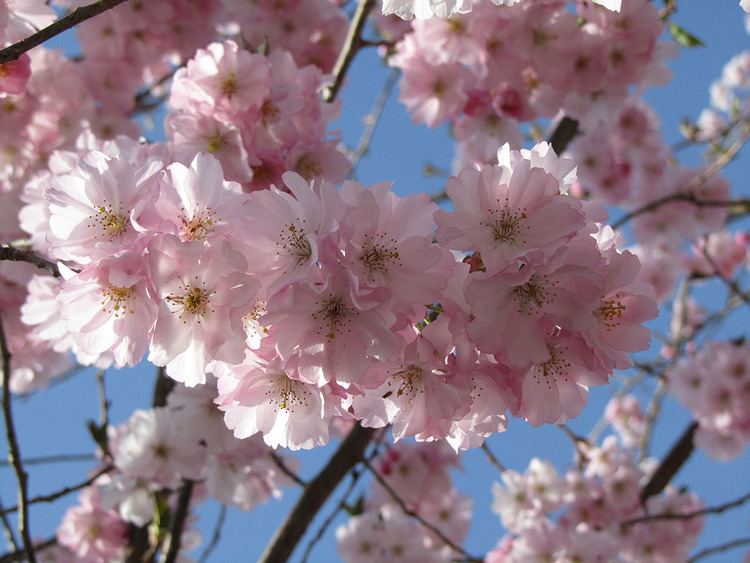 | ||
Lower classifications Almond, Peach, Cerasus, Sweet Cherry, Armenian plum | ||
Prunus is a genus of trees and shrubs, which includes the plums, cherries, peaches, nectarines, apricots and almonds.
Contents
- Botany
- Linnean classification
- Modern classification
- Cultivation
- Flowering cherries
- Other uses
- Toxicity
- Pests and diseases
- Species
- Palaeobotanical models
- Etymology
- References
Around 430 species are spread throughout the northern temperate regions of the globe. Many members of the genus are widely cultivated for fruit and ornament. The fruit from this genus are commonly called the stone fruit.
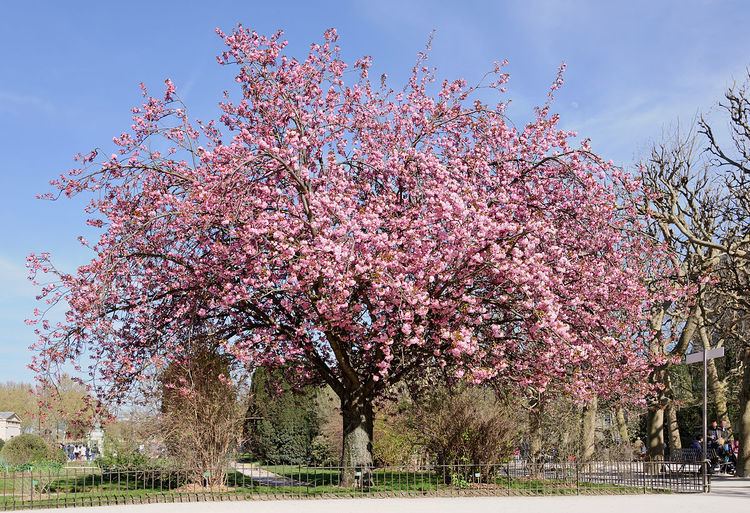
Botany

Members of the genus can be deciduous or evergreen. A few species have spiny stems. The leaves are simple, alternate, usually lanceolate, unlobed, and often with nectaries on the leaf stalk. The flowers are usually white to pink, sometimes red, with five petals and five sepals. There are numerous stamens. Flowers are borne singly, or in umbels of two to six or sometimes more on racemes. The fruit is a fleshy drupe (a "prune") with a single relatively large, hard-coated seed (a "stone").
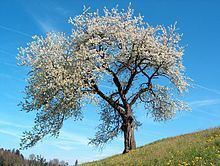
Within the rose family Rosaceae, it was traditionally placed as a subfamily, the Amygdaloideae (incorrectly "Prunoideae"), but was sometimes placed in its own family, the Prunaceae (or Amygdalaceae). More recently, it has become apparent that Prunus evolved from within a much larger clade now called subfamily Amygdaloideae (incorrectly "Spiraeoideae").
Linnean classification

In 1737, Carl Linnaeus used four genera to include the species of modern Prunus—Amygdalus, Cerasus, Prunus and Padus—but simplified it to Amygdalus and Prunus in 1758. Since then, the various genera of Linnaeus and others have become subgenera and sections, as it is clearer that all the species are more closely related. Liberty Hyde Bailey says:
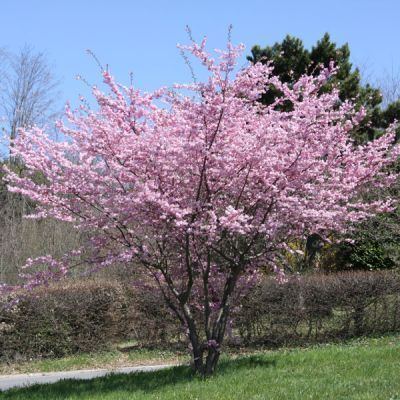
Modern classification
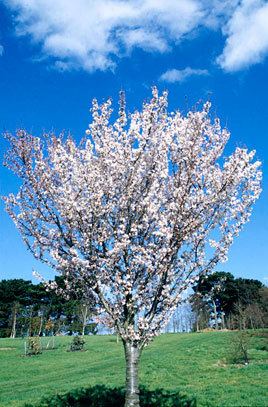
A recent DNA study of 48 species concluded that Prunus is monophyletic and is descended from some Eurasian ancestor.
Historical treatments break the genus into several different genera, but this segregation is not currently widely recognised other than at the subgeneric rank. ITIS recognises just the single genus Prunus, with an open list of species, all of which are shown below, under "Species".
One standard modern treatment of the subgenera derives from the work of Alfred Rehder in 1940. Rehder hypothesized five subgenera: Amygdalus, Prunus, Cerasus, Padus and Laurocerasus. To them C. Ingram added Lithocerasus. The six subgenera are described as follows:
Another recent DNA study found that there are two clades: Prunus-Maddenia, with Maddenia basal within Prunus, and Exochorda-Oemleria-Prinsepia, but further refinement shows that Exochorda-Oemleria-Prinsepia is somewhat separate from Prunus-Maddenia-Pygeum, and that, like the traditional subfamily Maloideae with apple-like fruits, all of these genera appear to be best considered within the expanded subfamily Amygdaloideae. Prunus can be divided into two clades: Amygdalus-Prunus and Cerasus-Laurocerasus-Padus. Yet another study adds Emplectocladus as a subgenus to the former.
Cultivation
The genus Prunus includes the almond, apricot, cherry, peach and plum, all of which have cultivars developed for commercial fruit and nut production. The edible part of the almond is the seed; the almond fruit is a drupe, not a true nut. Many other species are occasionally cultivated or used for their seed and fruit.
Flowering cherries
A number of species, hybrids, and cultivars are also grown as ornamental plants, usually for their profusion of flowers, sometimes for ornamental foliage and shape, and occasionally for their bark. These ornamentals include the group that may be collectively called "flowering cherries" (including sakura, the Japanese flowering cherries).
The following hybrid cultivars have gained the Royal Horticultural Society's Award of Garden Merit. All are described as flowering cherries, and are valued for their spring blossom.
Other uses
Species such as blackthorn (Prunus spinosa), are grown for hedging, game cover, and other utilitarian purposes.
The wood of some species (notably black cherry) is prized as a furniture and cabinetry timber, especially in North America.
Many species produce an aromatic resin from wounds in the trunk; this is sometimes used medicinally. Other minor uses include dye production.
Pygeum, a herbal remedy containing extracts from the bark of Prunus africana, is used as to alleviate some of the discomfort caused by inflammation in patients suffering from benign prostatic hyperplasia.
Because of their considerable value as both food and ornamental plants, many Prunus species have been introduced to parts of the world to which they are not native, some becoming naturalised.
Prunus species are food plants for the larvae of a large number of Lepidoptera species (butterflies and moths); see List of Lepidoptera which feed on Prunus.
Prunus sp. is included in the Tasmanian Fire Service's list of low flammability plants, indicating that it is suitable for growing within a building protection zone.
The Tree of 40 Fruit has forty varieties grafted on to one rootstock.
Toxicity
Many species are cyanogenic; that is, they contain compounds called cyanogenic glucosides, notably amygdalin, which, on hydrolysis, yield hydrogen cyanide. Although the fruits of some may be edible by humans and livestock (in addition to the ubiquitous fructivory of birds), seeds, leaves and other parts may be toxic, some highly so. The plants contain no more than trace amounts of hydrogen cyanide, but on decomposition after crushing and exposure to air or on digestion, poisonous amounts may be generated. The trace amounts may give a characteristic taste ("bitter almond") with increasing bitterness in larger quantities, less tolerable to people than to birds, which habitually feed on specific fruits.
Pests and diseases
Various Prunus species are winter hosts of the Damson-hop aphid, Phorodon humuli, which is destructive to hops Humulus lupulus just at the time of their maturity, so it is recommended that plum trees not be grown in the vicinity of hop fields.
Corking is a nutritional disorder in stone fruit caused by a lack of boron and/or calcium.
Species
The lists below are incomplete, but include most of the better-known species.
Palaeobotanical models
The earliest known fossil Prunus specimens are wood, drupe and seed and a leaf from the middle Eocene of the Princeton Chert of British Columbia. Using the known age as calibration data, recent research by Oh and Potter reconstructs a partial phylogeny of some Rosaceae from a number of nucleotide sequences. According to this study, Prunus and its "sister clade" Maloideae (apple subfamily) diverged at 44.3 mya (or 43 million years ago, well before most of the primates existed). This date is within the Lutetian, or older middle Eocene. Stokey and Wehr report: "The Eocene was a time of rapid evolution and diversification in Angiosperm families such as the Rosaceae ...."
The Princeton finds are among a large number of angiosperm fossils from the Okanagan Highlands dating to the late early and middle Eocene. Crataegus is found at three locations: Mcabee, Republic and Princeton, while Prunus is found at those locations and Quilchena and Chuchua. A recent recapitulation of research on the topic reported that the Rosaceae were more diverse at higher altitudes. The Okanagan formations date to as early as 52 mya, but the 44.3 mya date, which is approximate, depending on assumptions, might still apply. The authors state: "... the McAbee flora records a diverse early middle Eocene angiosperm-dominated forest."
Etymology
The Online Etymology Dictionary presents the customary derivations of plum and prune from Latin prūnum, the plum fruit. The tree is prūnus; and Pliny uses prūnus silvestris to mean the blackthorn. The word is not native Latin, but is a loan from Greek προῦνον (prounon), which is a variant of προῦμνον (proumnon), origin unknown. The tree is προύμνη (proumnē). Most dictionaries follow Hoffman, Etymologisches Wörterbuch des Griechischen, in making some form of the word a loan from a pre-Greek language of Asia Minor, related to Phrygian.
The first use of Prunus as a genus name was by Carl Linnaeus in Hortus Cliffortianus of 1737, which went on to become Species Plantarum. In that work, Linnaeus attributes the word to "Varr.", who it is assumed must be Marcus Terentius Varro.
